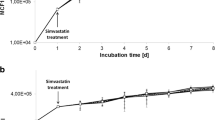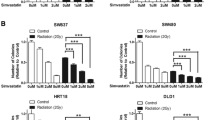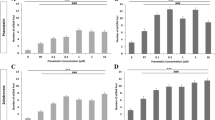Abstract
Although there is some evidence in animal studies that cholesterol signaling mediates radiation sensitivity of normal tissues, until recently, no connection had been made between cholesterol signaling and tumor radiosensitivity. Aberrant cholesterol signaling in breast cancer promotes oncogenesis and tumor progression by either altering membrane fluidity, membrane associated rafts, or as a direct activator of transcription. Cholesterol is synthesized de novo by the mevalonate pathway. A causal role for hydroxy-3-methylglutaryl-coenzyme A reductase, a rate-limiting enzyme of the mevalonate pathway, in oncogenic transformation, progression, and sensitivity to treatment offers an opportunity for drugs that inhibit this enzyme (i.e., statins) as well as other cholesterol mediating strategies as radiosensitizing treatments. This review discusses potential mechanisms by which statins alter cholesterol signaling in breast cancer and potentially enhances radiation sensitivity and outcome with a special focus on inflammatory breast cancer.
Similar content being viewed by others
References
Papers of particular interest, published recently, have been highlighted as: • Of importance •• Of major importance
Wolfe AR et al. High-density and very-low-density lipoprotein have opposing roles in regulating tumor-initiating cells and sensitivity to radiation in inflammatory breast cancer. Int J Radiat Oncol Biol Phys. 2015;91:1072–80. doi:10.1016/j.ijrobp.2014.12.039. This is the first study to link dyslipidemia with cancer stem cell self-renewal and radiation response in inflammatory breast cancer.
Butt S et al. The target for statins, HMG-CoA reductase, is expressed in ductal carcinoma-in situ and may predict patient response to radiotherapy. Ann Surg Oncol. 2014;21:2911–9. doi:10.1245/s10434-014-3708-4. This paper provides clinically relevant evidence demonstrating that the main target of statins, HMGCR, is highly expressed in early stage breast cancer and predicts response to radiation therapy. Data strongly supports HMCGR as a biomarker of response to radiation therapy alone or in combination with statins.
Stewart FA et al. Ionizing radiation accelerates the development of atherosclerotic lesions in ApoE−/− mice and predisposes to an inflammatory plaque phenotype prone to hemorrhage. Am J Pathol. 2006;168:649–58. doi:10.2353/ajpath.2006.050409.
Rosenson RS et al. Dysfunctional HDL and atherosclerotic cardiovascular disease. Nat Rev Cardiol. 2015. doi:10.1038/nrcardio.2015.124.
Reiner Z. Management of patients with familial hypercholesterolaemia. Nat Rev Cardiol. 2015;12:565–75. doi:10.1038/nrcardio.2015.92.
Goldstein JL, Brown MS. A century of cholesterol and coronaries: from plaques to genes to statins. Cell. 2015;161:161–72. doi:10.1016/j.cell.2015.01.036.
Clendening JW, Penn LZ. Targeting tumor cell metabolism with statins. Oncogene. 2012;31:4967–78. doi:10.1038/onc.2012.6.
Konstantinopoulos PA, Karamouzis MV, Papavassiliou AG. Post-translational modifications and regulation of the RAS superfamily of GTPases as anticancer targets. Nat Rev Drug Discov. 2007;6:541–55. doi:10.1038/nrd2221.
Clendening JW et al. Dysregulation of the mevalonate pathway promotes transformation. Proc Natl Acad Sci U S A. 2010;107:15051–6. doi:10.1073/pnas.0910258107.
Nguyen VT et al. Differential epigenetic reprogramming in response to specific endocrine therapies promotes cholesterol biosynthesis and cellular invasion. Nat Commun. 2015;6:10044. doi:10.1038/ncomms10044. This study elucidated a novel mechanism of resistance to aromatase inhibitors (AI) in breast cancer via enhanced cholesterol biosynthesis. Importantly, Statin treatment decreased 27-hydroxycholesterol-mediated estrogen receptor binding and cell invasion of AI-resistant breast cancer cells.
Bonovas S, Lytras T, Sitaras NM. Statin use and breast cancer: do we need more evidence and what should this be? Expert Opin Drug Saf. 2014;13:271–5. doi:10.1517/14740338.2014.888806.
Hamelin BA, Turgeon J. Hydrophilicity/lipophilicity: relevance for the pharmacology and clinical effects of HMG-CoA reductase inhibitors. Trends Pharmacol Sci. 1998;19:26–37.
Wolfe AR et al. Simvastatin prevents triple-negative breast cancer metastasis in pre-clinical models through regulation of FOXO3a. Breast Cancer Res Treat. 2015;154:495–508. doi:10.1007/s10549-015-3645-3. Strong pre-clinical evidence is provided demonstrating that statins inhibit lung and brain metastasis of TNBC and IBC cells in a variety of in vivo mouse models. Mechanistically, statin mediated effects occur through stabilization of FOXO3a.
Kozar K et al. Cerivastatin demonstrates enhanced antitumor activity against human breast cancer cell lines when used in combination with doxorubicin or cisplatin. Int J Oncol. 2004;24:1149–57.
Budman DR, Tai J, Calabro A. Fluvastatin enhancement of trastuzumab and classical cytotoxic agents in defined breast cancer cell lines in vitro. Breast Cancer Res Treat. 2007;104:93–101. doi:10.1007/s10549-006-9395-5.
White CP. On the occurrence of crystals in tumors. J Pathol Bacteriol. 1909;13:3–10.
Waxler SH, Tabar P, Melcher LR. Obesity and the time of appearance of spontaneous mammary carcinoma in C3H mice. Cancer Res. 1953;13:276–8.
Llaverias G et al. Role of cholesterol in the development and progression of breast cancer. Am J Pathol. 2011;178:402–12. doi:10.1016/j.ajpath.2010.11.005.
Alikhani N et al. Mammary tumor growth and pulmonary metastasis are enhanced in a hyperlipidemic mouse model. Oncogene. 2013;32:961–7. doi:10.1038/onc.2012.113.
Nelson ER et al. 27-Hydroxycholesterol links hypercholesterolemia and breast cancer pathophysiology. Science. 2013;342:1094–8. doi:10.1126/science.1241908. Data presented in this study proved a causal effect of cholesterol metabolite 27-hydroxycholesterol in ER-dependent growth and LXR-mediated metastasis of hormone positive breast cancer. Further it supports design of future clinical trials of statins alone or in combination with hormonal therapies for ER-positive breast cancer.
Pelton K et al. Hypercholesterolemia induces angiogenesis and accelerates growth of breast tumors in vivo. Am J Pathol. 2014;184:2099–110. doi:10.1016/j.ajpath.2014.03.006. This study used a well-controlled preclinical mouse model of hypercholesterolemia to demonstrate that high serum cholesterol levels are associated with accelerated breast cancer growth and microvessel density of orthotopically implanted MDAMB231 cells.
Wu Q et al. 27-Hydroxycholesterol promotes cell-autonomous. ER-positive breast cancer growth. Cell Rep. 2013;5:637–45. doi:10.1016/j.celrep.2013.10.006.
Phillips TM, McBride WH, Pajonk F. The response of CD24(-/low)/CD44+ breast cancer-initiating cells to radiation. J Natl Cancer Inst. 2006;98:1777–85. doi:10.1093/jnci/djj495.
Woodward WA et al. WNT/beta-catenin mediates radiation resistance of mouse mammary progenitor cells. Proc Natl Acad Sci U S A. 2007;104:618–23. doi:10.1073/pnas.0606599104.
Lagadec C et al. Survival and self-renewing capacity of breast cancer initiating cells during fractionated radiation treatment. Breast Cancer Res. 2010;12:R13. doi:10.1186/bcr2479.
Lacerda L et al. Simvastatin radiosensitizes differentiated and stem-like breast cancer cell lines and is associated with improved local control in inflammatory breast cancer patients treated with postmastectomy radiation. Stem Cells Transl Med. 2014;3:849–56. doi:10.5966/sctm.2013-0204. This study demonstrated an association between statin used and increased locoregional recurrence free survival after postmastectomy radiation therapy in IBC patients and provided evidence of statin-mediated radiosensitization of TICs of IBC.
Ginestier C et al. Mevalonate metabolism regulates basal breast cancer stem cells and is a potential therapeutic target. Stem Cells. 2012;30:1327–37. doi:10.1002/stem.1122.
Nubel T, Damrot J, Roos WP, Kaina B, Fritz G. Lovastatin protects human endothelial cells from killing by ionizing radiation without impairing induction and repair of DNA double-strand breaks. Clin Cancer Res. 2006;12:933–9. doi:10.1158/1078-0432.CCR-05-1903.
Ostrau C et al. Lovastatin attenuates ionizing radiation-induced normal tissue damage in vivo. Radiother Oncol. 2009;92:492–9. doi:10.1016/j.radonc.2009.06.020.
Monceau V et al. Modulation of the Rho/ROCK pathway in heart and lung after thorax irradiation reveals targets to improve normal tissue toxicity. Curr Drug Targets. 2010;11:1395–404.
Lenarczyk M et al. Simvastatin mitigates increases in risk factors for and the occurrence of cardiac disease following 10 Gy total body irradiation. Pharmacol Res Perspect. 2015;3:e00145. doi:10.1002/prp2.145. Data from this important paper demonstrates that statins can inhibit undesired effects of total body irradiation systemic and non systemic effects on normal tissue such as cardiac dysfunction, cellular fibrosis, and increased content of systemic LDL and triglycerides. It supports the use of statins along with radiation therapy for breast cancer to target cancer cells with dysregulated mevalonate pathway while protecting against cardiac disease.
Zhang SH, Reddick RL, Piedrahita JA, Maeda N. Spontaneous hypercholesterolemia and arterial lesions in mice lacking apolipoprotein E. Science. 1992;258:468–71.
Plump AS et al. Severe hypercholesterolemia and atherosclerosis in apolipoprotein E-deficient mice created by homologous recombination in ES cells. Cell. 1992;71:343–53.
Hoving S et al. Single-dose and fractionated irradiation promote initiation and progression of atherosclerosis and induce an inflammatory plaque phenotype in ApoE(−/−) mice. Int J Radiat Oncol Biol Phys. 2008;71:848–57. doi:10.1016/j.ijrobp.2008.02.031.
Clarke M et al. Effects of radiotherapy and of differences in the extent of surgery for early breast cancer on local recurrence and 15-year survival: an overview of the randomised trials. Lancet. 2005;366:2087–106. doi:10.1016/S0140-6736(05)67887-7.
Meyers MO et al. Impact of breast cancer molecular subtypes on locoregional recurrence in patients treated with neoadjuvant chemotherapy for locally advanced breast cancer. Ann Surg Oncol. 2011;18:2851–7. doi:10.1245/s10434-011-1665-8.
Panoff JE et al. Risk of locoregional recurrence by receptor status in breast cancer patients receiving modern systemic therapy and post-mastectomy radiation. Breast Cancer Res Treat. 2011;128:899–906. doi:10.1007/s10549-011-1495-1.
Mandal CC, Ghosh-Choudhury N, Yoneda T, Choudhury GG, Ghosh-Choudhury N. Simvastatin prevents skeletal metastasis of breast cancer by an antagonistic interplay between p53 and CD44. J Biol Chem. 2011;286:11314–27. doi:10.1074/jbc.M110.193714.
Dontu G et al. In vitro propagation and transcriptional profiling of human mammary stem/progenitor cells. Genes Dev. 2003;17:1253–70. doi:10.1101/gad.1061803.
Wang X et al. Macrophage ABCA1 and ABCG1, but not SR-BI, promote macrophage reverse cholesterol transport in vivo. J Clin Invest. 2007;117:2216–24. doi:10.1172/JCI32057.
Out R et al. Combined deletion of macrophage ABCA1 and ABCG1 leads to massive lipid accumulation in tissue macrophages and distinct atherosclerosis at relatively low plasma cholesterol levels. Arterioscler Thromb Vasc Biol. 2008;28:258–64. doi:10.1161/ATVBAHA.107.156935.
Yvan-Charvet L et al. Combined deficiency of ABCA1 and ABCG1 promotes foam cell accumulation and accelerates atherosclerosis in mice. J Clin Invest. 2007;117:3900–8. doi:10.1172/JCI33372.
Rayner KJ et al. MiR-33 contributes to the regulation of cholesterol homeostasis. Science. 2010;328:1570–3. doi:10.1126/science.1189862.
Najafi-Shoushtari SH et al. MicroRNA-33 and the SREBP host genes cooperate to control cholesterol homeostasis. Science. 2010;328:1566–9. doi:10.1126/science.1189123.
Marquart TJ, Allen RM, Ory DS, Baldan A. miR-33 links SREBP-2 induction to repression of sterol transporters. Proc Natl Acad Sci U S A. 2010;107:12228–32. doi:10.1073/pnas.1005191107.
Kennedy MA et al. Characterization of the human ABCG1 gene: liver X receptor activates an internal promoter that produces a novel transcript encoding an alternative form of the protein. J Biol Chem. 2001;276:39438–47. doi:10.1074/jbc.M105863200.
El Roz A, Bard JM, Huvelin JM, Nazih H. LXR agonists and ABCG1-dependent cholesterol efflux in MCF-7 breast cancer cells: relation to proliferation and apoptosis. Anticancer Res. 2012;32:3007–13.
Wolfe, A. et al. MiR-33a negatively regulates high-density lipoprotein-induced radiation sensitivity in breast cancer. Int J Rad Biol Oncol Phys (2016).
Woodward WA. Inflammatory breast cancer: unique biological and therapeutic considerations. Lancet Oncol. 2015;16:e568–76. doi:10.1016/S1470-2045(15)00146-1. This review provides the latest update on IBC biology and treatment. Furthermore, it offers a new perspective on targeting the tumor microenvironment from a radiation oncology point of view.
Brewer TM et al. Statin use in primary inflammatory breast cancer: a cohort study. Br J Cancer. 2013;109:318–24. doi:10.1038/bjc.2013.342.
Vinayak S et al. A clinical trial of lovastatin for modification of biomarkers associated with breast cancer risk. Breast Cancer Res Treat. 2013;142:389–98. doi:10.1007/s10549-013-2739-z.
Shai A et al. Statins, aspirin and risk of venous thromboembolic events in breast cancer patients. J Thromb Thrombolysis. 2014;38:32–8. doi:10.1007/s11239-013-1015-8.
Bjarnadottir O et al. Targeting HMG-CoA reductase with statins in a window-of-opportunity breast cancer trial. Breast Cancer Res Treat. 2013;138:499–508. doi:10.1007/s10549-013-2473-6. This study demonstrated that effect of pre-operative administration of atorvastatin in breast cancer patients is associated with decreased proliferation (lower Ki67) in HMGCR-positive tumors and supports future trials to evaluate HMGCR expression as a predictive biomarker of response to statins in breast cancer.
Lazzeroni M et al. Breast ductal lavage for biomarker assessment in high risk women: rationale, design and methodology of a randomized phase II clinical trial with nimesulide, simvastatin and placebo. BMC Cancer. 2012;12:575. doi:10.1186/1471-2407-12-575.
Higgins MJ et al. A short-term biomarker modulation study of simvastatin in women at increased risk of a new breast cancer. Breast Cancer Res Treat. 2012;131:915–24. doi:10.1007/s10549-011-1858-7.
Garwood ER et al. Fluvastatin reduces proliferation and increases apoptosis in women with high grade breast cancer. Breast Cancer Res Treat. 2010;119:137–44. doi:10.1007/s10549-009-0507-x.
Taunk NK, Haffty BG, Goyal S. Radiation recall 5 years after whole-breast irradiation for early-stage breast cancer secondary to initiation of rosuvastatin and amlodipine. J Clin Oncol : Off J Am Soc Clin Oncol. 2011;29:e661–3. doi:10.1200/JCO.2011.35.7202.
Acknowledgments
This work was supported by the National Institutes of Health R01CA138239-01 and 1R01CA180061-01, the State of Texas Grant for Rare and Aggressive Breast Cancer Research Program, the Inflammatory Breast Cancer Network Grant, and an institutional research grant from The University of Texas MD Anderson Cancer Center. The Research Animal Support Facility-Houston, Small Animal Imaging Facility, Flow Cytometry and Cellular Imaging Facility, and Research Histopathology Facility are supported in part by the National Institutes of Health through MD Anderson Cancer Center Support (core) Grant CA016672.
Author information
Authors and Affiliations
Corresponding author
Ethics declarations
Conflict of Interest
Omar M. Rahal and Wendy A. Woodward declare that they have no conflict of interest.
Human and Animal Rights and Informed Consent
This article does not contain any studies with human or animal subjects performed by any of the authors.
Additional information
This article is part of the Topical Collection on Translational Research
Rights and permissions
About this article
Cite this article
Rahal, O.M., Woodward, W.A. Cholesterol and Radiosensitivity. Curr Breast Cancer Rep 8, 32–39 (2016). https://doi.org/10.1007/s12609-016-0202-y
Published:
Issue Date:
DOI: https://doi.org/10.1007/s12609-016-0202-y




